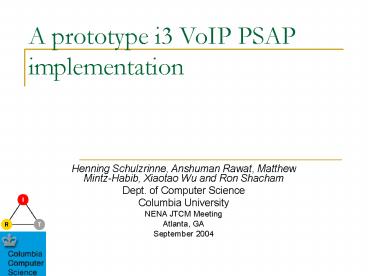A prototype i3 VoIP PSAP implementation
Title:
A prototype i3 VoIP PSAP implementation
Description:
151.algonquin-dr.addison.vt.us.sos-arpa.net. Perl sip-cgi script. DNS NAPTR: addison.vt.us ... Caller location displayed on map. Caller information displayed in GUI. ... –
Number of Views:150
Avg rating:3.0/5.0
Title: A prototype i3 VoIP PSAP implementation
1
A prototype i3 VoIP PSAP implementation
- Henning Schulzrinne, Anshuman Rawat, Matthew
Mintz-Habib, Xiaotao Wu and Ron Shacham - Dept. of Computer Science
- Columbia University
- NENA JTCM Meeting
- Atlanta, GA
- September 2004
2
Overview
- A quick review of I3 assumptions
- Goals of project
- Prototype architecture and experiences
- Scaling and robustness
- Next steps
3
Our I3 assumptions
- VoIP (SIP) capable end systems
- SIP-capable PSAP
- Location inserted by origin
- outbound proxy
- originating device (e.g., via DHCP)
- either geospatial or civic location
4
Goals of prototype
- Provide a platform for quick experimentation
- Determine easy vs. hard parts of problem
- Experiment with redundancy and robustness
- Use off-the-shelf components where possible
- Modes
- Phase II wireless (based on ALI lookup)
- I3 VoIP end-to-end, with in-band location
information
5
Components
sipd SIP proxy server
database-backed DNS server
SIP phone
web server
SQL database for call routing
sipc SIP user agent
geo-coding, PSAP boundaries
GIS software for call location plotting
No endorsement implied other components likely
will work as well
6
Prototype
gray features in progress.
7
Demo prototype
Ft. Wayne, IN August 17, 2004
8
Call routing
- PSAP lookup depends on location type
- DNS for civic locations
- Mapinfo Envinsa for geo location
9
Detail I3 - DNS-based resolution
DHCP INFORM
psap.state.vt.gov
SIP w/location
MAC ? loc
Perl sip-cgi script
psap.state.vt.gov
DNS NAPTR addison.vt.us algonquin-dr.addison.vt.u
s
proprietary TCP-based protocol
151.algonquin-dr.addison.vt.us.sos-arpa.net
10
Call taker setup
SIPc client receives calls
GeoLynx software displays caller location
11
sipc receives call
12
GeoLynx displays location
GeoLynx receives commands and displays location.
Caller location displayed on map.
Caller information displayed in GUI.
GeoLynx listens for commands from SIPc
13
Demo Ft. Wayne, IN (August 17, 2004)
14
White PSAP
15
Red PSAP
16
Blue PSAP
17
Close-up of PSAP call taker station
18
Using IP phones for voice
redundant sipds
XML display shows caller location
Apache web server
XML display with HTTP retrieval
19
Emergency call conferencing
PSAP brings all related parties into a
conference call
Hospital
Fire department
INVITE
Conference server
Recorder
3rd party call control
PSAP
Caller
20
Scaling
- NENA estimated 200 million calls to 9-1-1 in
the U.S. each year - ? approximately 6.3 calls/second
- if 3 minute call, about 1,200 concurrent calls
- typical SIP proxy server (e.g., sipd) on 1 GHz PC
can handle about 400 call arrivals/second - thus, unlikely to be server-bound
21
Next steps for our prototype
- Custom user interface for call taker
- Add voice recording and conferencing
- using our software conference server
- Data mining
- collect and display statistical data about calls
- Integration of police/fire/EMS
- direct transmission of call-related data via
simple IM application ? requires only Internet
access
22
Difficulties
- Difficult to get good test environment
- access to PDE
- IP access to ALI (often, jury-rigged telnet
interfaces) - access to MSAG and ALI data
- friendly PSAPs one option
- but open, network-accessible test lab would be
better - longer-term may need plug fests
- see SIPit effort vendors collaborating in
friendly, non-public interop test efforts ? rapid
elimination of protocol and implementation
problems
23
Conclusion
- A first prototype of I3 PSAP
- integrates Phase II wireless call delivery
- Shown that it is possible to integrate existing
GIS applications with I3 - Based on COTS technology, with modest
modifications - Additional operational support in progress































